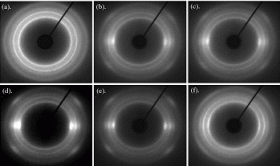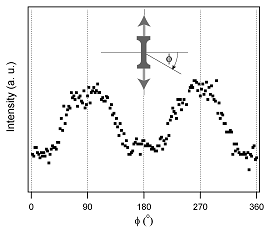
Much of our manufactured environment - many metals, plastics, glasses, ceramics, fiberglass, - are extrusion-molded articles. To minimize waste, extrusion-molding plants must balance quality of product, speed of process and cost of production (primarily electricity) for each material. They need to know how fast each material can be processed at what energy cost while maintaining the quality of the finished bulk material.
In the case of plastic materials (polymers) optimizing this task is advantaged by the fact that the macromolecular arrangement of many polymers, including the commonly used polypropylene derivatives reported here, changes fundamentally only at certain critical deformation rates. These critical deformation rates are themselves influenced by the tacticity of the molecule and can therefore be tailored with careful synthesis.
The SSRL-enabled research here correlates the molecular structure of the material with its bulk material properties and uncovers those key shear and extrusion rates.
In this study three distinct tacticity fractions of a polypropylene elastomer were prepared, which varied in tacticity: a measure of the repeat symmetry of the monomer unit along the polymer chain. Deformation of the elastomer was performed in-situ in the x-ray probe beam using a custom made tensile testing device on BL1-4 (Figure 1). The tensile tester monitored the rate of applied deformation simultaneously with collecting small angle and wide angle x-ray scattering (SAXS and WAXS) data from which molecular orientations were determined.

Stretching the plastic material yields three sets of scattering geometries: isotropic (complete rings) equatorial and off-axis diagonal (Figure 2). High-tacticity fractions contribute to the equatorial and off-axis diagonal scatterings revealing molecular-scale orientation parallel to the strain axis and crystalline phase transformation from the a-form to the mesomorphic form. The meridional arc is contributed by the low-tacticity fraction with crystalline chains oriented with a preferred direction orthogonal relative to the strain direction. SAXS, which probes long-range ordering, exhibits broad and diffuse meridional peak for the intermediate-tacticity fraction (Figure 3).
These scattering results were combined with birefringence measurements, and wide-angle diffraction data also collected at BL1-4 to complete the characterization of the molecular organization of the elastomeric material to physical deformation.

The resulting data allowed determination of the precise degree to which lamellae are oriented to the strain direction, and the surprising revelation that in certain cases this orientation is reproducibly orthogonal to the direction of strain. Permanent deformation of the elastomer after stretching, as measured by the residual strain (tensile set), originates from permanently oriented crystallites and chains pinned within crystalline networks. This model is adopted from the work of Schultz 4 and is shown in Figure 4. There is also evidence of co-crystallization in the lowest tacticity polypropylene fraction which proportions can be controlled through the application of step strain shear.
Plants currently operating above the revealed optimum deformation rates are thereby enabled to save substantial electrical and environmental costs by reducing extrusion speed while retaining or improving the desired bulk rheological qualities in the finished product. The quality, profit and environmental implications of this procedure for industry are difficult to overemphasize.
This research was carried out at the Stanford Synchrotron Radiation Laboratory, a national user facility operated by Stanford University on behalf of the U.S. Department of Energy, Office of Basic Energy Sciences.
- W. Wiyatno, G. G. Fuller, J. A. Pople, A. P. Gast, Z. Chen, R. M. Waymouth, C. L. Myers, Macromolecules 2003, 36, 4, 1178-1187.
- W. Wiyatno, J. A. Pople, A. P. Gast, R. M. Waymouth, G. G. Fuller, Macromolecules 2002, 35, 22, 8488-8497.
- W. Wiyatno, J. A. Pople, A. P. Gast, R. M. Waymouth, G. G. Fuller, Macromolecules 2002, 35, 22, 8498-8508.
- J. M. Schultz, "Polymer Materials Science," 1974, Prentice Hall, Englewood Cliffs, NJ.
W. Wiyatno, J. A Pople, A. P Gast, R. M Waymouth and G. G Fuller, "Dynamic Response of Stereoblock Elastomeric Polypropylene Studied by Rheooptics and X-ray Scattering. 1. Influence of Isotacticity", Macromolecules 35, 8488 (2002)
W. Wiyatno, J. A Pople, A. P Gast, R. M Waymouth and G. G Fuller, "Dynamic Response of Stereoblock Elastomeric Polypropylene Studied by Rheooptics and X-ray Scattering. 2. Orthogonally Oriented Crystalline Chains", Macromolecules 35, 8498 (2002)
W. Wiyatno, G. G Fuller, J. A Pople, A. P Gast, Z. Chen, R. M Waymouth and C. L Myers, "Component Stress-Strain Behavior and Small-Angle Neutron Scattering Investigation of Stereoblock Elastomeric Polypropylene", Macromolecules 36, 1178 (2003)




